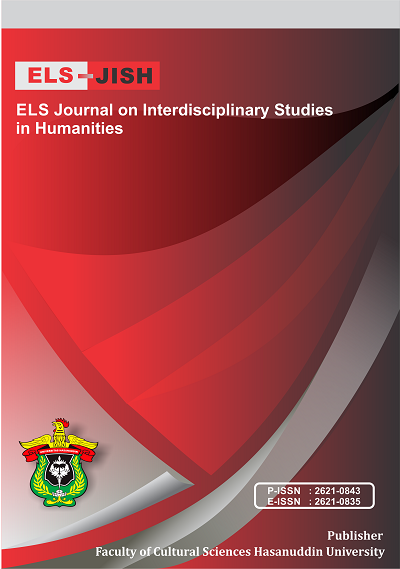The Personality Dimension Neuroticism, Extraversion, and Openness to experience that appears in the character in The Three button Trick and Other Stories by Nicola Barker
DOI:
https://doi.org/10.34050/elsjish.v7i2.35158Keywords:
Behaviour, Characters, Motivation, Personality, RelationAbstract
This study examines the relationship between the characters' personalities and the three personality dimensions—Neuroticism, Extroversion, and Openness to Experience—in Nicola Barker's novel *The Three Button Trick and Other Stories*. The research aims to identify the types of violations committed by the characters and to explore the personality dimension relationships depicted through their personalities. The theoretical framework for this research includes Paul Grice's theory of maxim violation, which is used to explain personality relations, and the Five Factor Theory introduced by McCrae and Costa, which helps describe the personalities of the characters. A qualitative research method is employed to analyses the data, focusing on the maxim relations produced by the characters that reflect their personalities during communication. The data is collected from the text, sorted, analysed, and described according to the research needs. Triangulation is used to combine various data and sources for analysis. The results reveal that there are violations of maxim relations, habits, and personality exchange functions, demonstrating that personalities are interconnected. Ultimately, in the process of conversation, there can be a mutual understanding of the interlocutor's personality.
References
Al-Saedi, H. T. J. (2013). A Pragmatic Study of the Cooperative Principle and Grice’s Maxims in Lois Lowry’s The Giver. Southern Illinois University.
Carolina, C. (2015). An Analysis of Non-observance Maxims in Humorous Conversation in How I Met Your Mother Season 2. Sanata Dharma University.
Faisal, F. (2010). English Letters Department Letters And Humanities Faculty State Islamic University. https://repository.uinjkt.ac.id/dspace/bitstream/123456789/3642/1/FAISAL-FAH.pdf
Göncz, A., Göncz, L., & Pekić, J. (2014). The Influence of Students’ Personality Traits on their Perception of a Good Teacher within the Five-Factor Model of Personality. Acta Polytechnica Hungarica, 11(03). https://doi.org/10.12700/APH.11.03.2014.03.5
Grice, H. (1975). Logic and Conversation. Academic.
Junaid, S., Nahdhiyah, N., Dahlan, D., Andini, C., & Dzulhijjah, A. M. (2024). The Portrayal of African Woman’s Struggle Reflected in the Novel “How Beautiful We Were” By Imbolo Mbue (2021). ELS Journal on Interdisciplinary Studies in Humanities, 7(2), 275-284.
Leech, G. (1983). Principle of Pragmatics. Longman Group Limited.
Leech, G., & Thomas, J. (1985). Pragmatics. The State of the Art. Lancaster University.
Mahsun, M. (2007). Metode Penelitian Bahasa (Ed. rev. 3). PT Raja Grafindo Persada.
McCrae, R., & T. Costa, P. (1997). Personality Trait Structure as a Human Universal. Journal American Psychologist, 52, 509–516.
Nimpuno, W. B., & Hasbi, R. M. (2022). Hubungan Antara Kepribadian Openness to Experience Terhadap Adaptasi Ruang Bekerja Dirumah. Vitruvian : Jurnal Arsitektur, Bangunan dan Lingkungan, 11(2), 183. https://doi.org/10.22441/vitruvian.2022.v11i2.009
P. John, O., & Srivastava, S. (1999). The Big-Five Trait Taxonomy: History, Measurement, and Theoretical Perspectives (2nd ed.). Department of Psychology University of California, MC 1650.
Prihandoko, L. A., Al Ahmad, A. S. M., & Rahman, F. (2022). Revitalizing Hospitality, Managerial, and English for Tourism Purposes Skills: Community Partnership Program for Hotel Employees in Merauke Regency. ABDIMAS: Jurnal Pengabdian Masyarakat, 5(2), 2524-2531.
Rahman, F. (2016). The Strategy of Teaching Literature through Language-based Methods: A Communicative Approach. In Annual Seminar on English Language Studies (Vol. 1, pp. 156-170).
Rahman, F. F., Ahmad, T. W. B., Badaruddin, S., & Andini, C. (2023). Moral Values in the Film Not One Less《 一个都不能少》 张艺谋对《 一个都不能少》 电影道德价值分析. ELS Journal on Interdisciplinary Studies in Humanities, 6(2), 376-390.
Rothmann, S., & Coetzer, E. P. (2003). The big five personality dimensions and job performance. SA Journal of Industrial Psychology, 29(1). https://doi.org/10.4102/sajip.v29i1.88
Sukmawaty, S., Andini, C., & Rahman, F. F. (2022). The Shift of Honorifics due to The Promotion As A Government Official: Comparative Study. ELS Journal on Interdisciplinary Studies in Humanities, 5(1), 166-176.
Taherdoost, H. (2021). Data collection methods and tools for research; a step-by-step guide to choose data collection technique for academic and business research projects. International Journal of Academic Research in Management (IJARM), 10(1), 10-38.
Taufik, T., Prihartanti, N., & Hamid, H. S. A. (2019). Neuroticism, Extraversion and Conscientiousness as Predictors of the Hedonistic Lifestyle. Universitas MuhammadiyahSurakarta.
Vedantu, V. (2024, May 22). Communication. Vedantu. https://www.vedantu.com/commerce/communication
Weda, S., Rahman, F., Samad, I. A., Gunawan, F., & Fitriani, S. S. (2022). How Millennials Can Promote Social Harmony through Intercultural Communication at Higher Education. Randwick International of Social Science Journal, 3(1), 231-243.
Youngsun, K., Sosrohadi, S., Andini, C., Jung, S., Yookyung, K., & Jae, P. K. (2024). Cultivating Gratitude: Essential Korean Thankfulness Phrases for Indonesian Learners. ELS Journal on Interdisciplinary Studies in Humanities, 7(2), 248-253.
Downloads
Published
Issue
Section
License
Copyright (c) 2024 Rosmiati Rosmiati, Era Wahyu Ningsih, Siti Norhidayah

This work is licensed under a Creative Commons Attribution-ShareAlike 4.0 International License.






